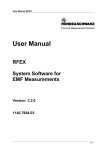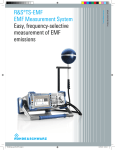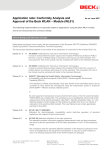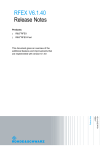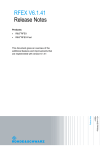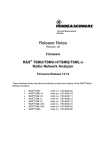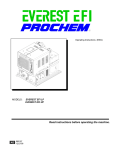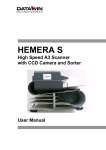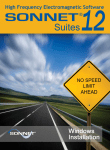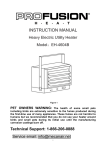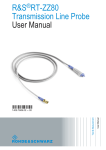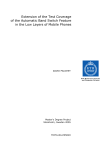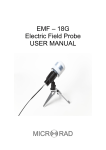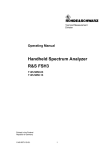Download User Manual
Transcript
TS-EMF Test and Measurement Division User Manual for TS-EMF Portable EMF Measurement System R&S 1158.9295.02 / 03 1158.9366.31 Version 2.1 TS-EMF Contents Contents 1 User Hints ........................................................................................... 4 1.1 Introduction ...................................................................................................... 4 1.2 Software-Updates............................................................................................. 5 1.3 Related Documents.......................................................................................... 5 2 Safety Instructions............................................................................. 6 3 Description.......................................................................................... 8 3.1 Use of the system TS-EMF .............................................................................. 8 4 Putting into Operation ....................................................................... 9 4.1 Operating Conditions ...................................................................................... 9 4.2 Cabling............................................................................................................ 10 4.2.1 4.2.2 4.2.3 4.2.4 Connecting the field sensor................................ ................................ ............................. 10 Connecting the FSH3 Spectrum Analyser ................................ ................................ ....... 10 Connecting the Measurement Receiver ESPI and the Spectrum Analysers FSP and FSU11 Connecting the Sync-Box TS95SYN (UMTS Option)................................ ....................... 11 5 Operation .......................................................................................... 12 5.1 Preparation of the measurements ................................................................ 12 5.2 System Calibration......................................................................................... 12 5.2.1 5.2.2 5.2.3 5.2.4 5.3 Hints for correction of the cable loss................................ ................................ ................ 13 Hints for correction of the Tri-Axis Probe ................................ ................................ ......... 13 Measurements at frequencies below 200 MHz................................ ................................ 14 Use of other antennas than Tri-Axis Probe ................................ ................................ ...... 14 Taking measurements ................................................................................... 15 5.3.1 5.3.2 5.3.3 5.3.4 5.3.5 5.3.6 5.3.7 5.3.8 5.3.9 5.3.10 Predefined Measurement Packets................................ ................................ ................... 16 Threshold Calibration................................ ................................ ................................ ...... 17 Predefined Limit Lines................................ ................................ ................................ ..... 18 Single Measurement................................ ................................ ................................ ....... 18 Scanning Measurement................................ ................................ ................................ .. 19 Measurements at different points ................................ ................................ .................... 20 Average Measurement................................ ................................ ................................ .... 20 Long term Measurement ................................ ................................ ................................ . 20 Measurement of Field Strength Distribution................................ ................................ ..... 21 Measurement Report................................ ................................ ................................ ... 21 2 TS-EMF Contents 6 Specification..................................................................................... 22 6.1 Data of the System R&S TS-EMF .................................................................. 22 7 Maintenance / Spare Parts .............................................................. 23 7.1 Maintenance ................................................................................................... 23 7.2 Check / Re-Calibration of the Tri-Axis Probe............................................... 23 7.3 Spare Parts ..................................................................................................... 23 8 Appendix ........................................................................................... 24 8.1 Circuit Diagram R&S TS-EMF system .......................................................... 24 8.2 Example for Report File................................................................................. 25 Appendix: CE Certificate of Conformity for TS-EMF 3 1 User Hints 1.1 Introduction The purpose of this user manual is to describe the operation of the portable EMF Measurement System R&S TS-EMF. The system is designed for measurements of the electrical field strength. For the major services measurement packets are defined. This ensures, that optimum settings are used and allows evaluation according to single frequencies, complete services and total emission. Due to configurability the system can be easily adopted to special measurement tasks. The main features of the system TS-EMF are • Wide frequency range 80 MHz (or 30 MHz) to 3 GHz covering all common radio services as - Mobile radio (GSM, CDMA and UMTS) - DECT - Bluetooth™ - WLAN (802.11b) - Sound broadcasting - TV broadcasting • Optional UMTS extension with CPICH-decoding (useable only with ESPI, FSP, FSU) • High sensitivity and dynamic range, e.g. in the GSM-range typ. 1 mV/m – 100 V/m (using different Packets) • Short- and long term measurements incl. average and peak values • Easy result interpretation by limits • Identification of emitter and service by frequency • Comparison of different emitters • Compact and portable • Indoor and outdoor use The System consists of the following components: • Spectrum Analyzer FSH3 1) • System TS-EMF Including: Software RFEX USB Hardlock for Software RFEX Isotropic Sensor Converter USB – TTL-I/O with USB cable Holder to mount the Tri-Axis Probe on a tripod USB-Hub, two ports Suitcase to take the above components Plastic support for placing a notebook on the FSH3 carrying bag Option TSEMF-U1 for UMTS measurements with CPICH decoding composed by sync box TS95SYN, R&S Id. Nr. 1114.4817.02 and software components TSEMF-US1 and TSEMF-O2 (only with ESPI or FSP) Option TSEMF-U2 for UMTS measurements with CPICH decoding composed by Radio Network Analyzer TSMU, R&S Id. Nr. 1153.6000.02 and software components TSEMFUS2 and TSEMF-O4 (only with TSMU) • • R&S Id. Nr. 1145.5850.03 R&S Id. Nr. 1145.5850.13 R&S Id. Nr. 1145.5850.23 R&S Id. Nr. 1158.9295.02, R&S Id. Nr. 1158.9295.03 1) Instead of the FSH3, other instruments like spectrum analyzers FSP, FSU and test receiver ESPI can be used with the system, too. 1158.9295.02 4 D-1 The system TS-EMF is controlled by the software RFEX. The computer to run the software RFEX is not part of the delivery and must be provided by customer. For detailed requirements on the computer refer to the manual of the software RFEX. 1.2 Software-Updates * Important Note Before updating the Software, a potentially installed previous version must be uninstalled via the Windows System Menu ! Customer-specific data and settings in the directory \RFEX\Data must be saved before and copied back to that directory after the update, if required! Software-Updates of the RFEX-Software are usually free of charge and can be downloaded from the Internet pages of Rohde&Schwarz. The download page can be found with a search on ‚TS-EMF’ under www.rohde-schwarz.com or via direct input of link below in a Browser. www.rohde-schwarz.com/www/dev_center.nsf/html/ts-emfdown To avoid misuse, the zipped data file is password protected. You can get the password from your Rohde&Schwarz sales office. 1.3 Related Documents Detailed information of the relevant system components are to be found in the following documents: • • User Manual Spectrum Analyzer FSH3 Software Manual RFEX Id. Nr. 1145.5973.11 Id. Nr. 1140.7984.03 The software manual RFEX is to be found on the CD delivered with the system. 1158.9295.02 5 D-1 2 Safety Instructions This unit has been designed and tested in accordance with the EC Certificate of Conformity and has left the manufacturer’s plant in a condition fully complying with safety standards. To maintain this condition and to ensure safe operation, the user must observe all instructions and warnings given in this operating manual. Safety-related symbols used on equipment and documentation from R&S: Observe operating instructions Weight indication for PE terminal Ground Terminal Danger! Shock hazard units >18 kg Warning! Hot surfaces Ground Attention! Electrostatic sensitive devices require special care 1. The R&S TS-EMF is protected against water and dust (IP degree 53). Unless otherwise agreed, the following applies: pollution severity 2, overvoltage category 2, altitude max. 2000 m. The unit may be operated only from supply networks fused with max. 16 A.. Unless specified otherwise in the data sheet, a tolerance of ±10% shall apply to the nominal voltage and of ±5% to the nominal frequency. 2. For measurements in circuits with voltages Vrms > 30 V, suitable measures should be taken to avoid any hazards. (using, for example, appropriate measuring equipment, fusing, current limiting, electrical separation, insulation). 3. For permanently installed units without built-in fuses, circuit breakers or similar protective devices, the supply circuit must be fused such as to provide suitable protection for the users and equipment. 4. Prior to switching on the unit, it must be ensured that the nominal voltage set on the unit matches the nominal voltage of the AC supply network. If a different voltage is to be set, the power fuse of the unit may have to be changed accordingly. 5. If the unit has no power switch for disconnection from the AC supply, the plug of the connecting cable is regarded as the disconnecting device. In such cases it must be ensured that the power plug is easily reachable and accessible at all times (length of connecting cable approx. 2 m). Functional or electronic switches are not suitable for providing disconnection from the AC supply. If units without power switches are integrated in racks or systems, a disconnecting device must be provided at system level. 6. Applicable local or national safety regulations and rules for the prevention of accidents must be observed in all work performed. Prior to performing any work on the unit or opening the unit, the latter must be disconnected from the supply network. Any adjustments, replacements of parts, maintenance or repair may be carried out only by authorized R&S technical personnel. Only original parts may be used for replacing parts relevant to safety (eg. power switches, power transformers, fuses). A safety test must be performed after each replacement of parts relevant to safety. (visual inspection, PE conductor test, insulation resistance, leakage-current measurement, functional test). 7. Ensure that the connections with information technology equipment comply with IEC950 / EN60950. 8. NiMH batteries must not be exposed to high temperatures or fire. Keep batteries away from children. If the battery is replaced improperly, there is danger of explosion. Only replace the battery by R&S type (see spare part list). NiMH batteries are suitable for environmentally friendly 1158.9295.02 6 D-1 9. 10. 11. 12. disposal or specialized recycling. Dispose them into appropriate containers, only. Do not shortcircuit the battery. Equipment returned or sent in for repair must be packed in the original packing or in packing with electrostatic and mechanical protection. Electrostatics via the connectors may damage the equipment. For the safe handling and operation of the equipment, appropriate measures against electrostatics should be implemented. The outside of the instrument is suitably cleaned using a soft, lint-free dustcloth. Never use solvents such as thinners, acetone and similar things, as they may damage the front panel labeling or plastic parts. Any additional safety instructions given in this manual are also to be observed. 1158.9295.02 7 D-1 3 Description 3.1 Use of the system TS-EMF The portable EMF Measurement System TS-EMF is designed for short-term and long-term measurements of the electromagnetic field (EMF). The purpose of the measurements is to observe the magnitude of highfrequency emissions as radiated by transmitters. The distribution of the measured emissions is shown with relation to the different services. The basic characteristic of the system TS-EMF is as follows: • • • • • • • • • Different measurement modes: • Single measurement (e.g. for overview) • Average and peak (e.g. 6 minutes average) • Long term (e.g. determination of time variations in the signals) Easy measurement configuration by selection of packets Calculation of the isotropic field strength value out of the measurements of the three axis. Data reduction via measurement software to reduce the amount of measurement data. Data presentation of the measured emissions (Field strength, power density and ‰ of limit) as a sum value and split into frequency bands. Mobile operation of the system R&S TS-EMF is ideal for outdoor and indoor use. Frequency range, depending on Sensor, from 30 MHz or from 80 MHz to 3 GHz. Field strength can be measured from about 1 mV/m up to 100 V/m UMTS decoding as optional extension Since the tri-axis sensor has got an isotropic characteristic, the measurement is done independent from direction or polarization of the emitter. This makes measurements easier. In contrast to directional antennas it is no longer necessary to move the antenna for covering all directions and polarization. 1158.9295.02 8 D-1 4 Putting into Operation The system R&S TS-EMF is operated together with the software R&S RFEX. This software runs on a standard computer (preferably a laptop). Details for software installation are contained in the Software Manual RFEX. Prior to each measurement the system TS-EMF has to be set up and put into operation according to the following chapters. Please refer to the circuit diagram in the appendix 8.1 of this manual. Attention! The System TS-EMF is not equipped with any lightning protection. Outdoor operation of the system is only allowed under suitable weather conditions. 4.1 Operating Conditions In order to obtain meaningful measurement results it is not recommended to use the system when it is raining. The Tri-Axis Probe of the system TS-EMF is able to withstand rain, but all components, especially the cables and connectors should be protected against moisture as far as possible. The spectrum analyzer FSH3 and the laptop are only allowed to be operated in dry environment (for example inside a car). Further information is available in the corresponding data sheets. The maximum field strength to be measured with the system is 100 V/m. Please note that the spectrum analyzer (and laptop) must not be exposed to field strengths above 10 V/m. In case of field strengths above 10 V/m (High power antennas or direct vicinity of a antenna) spectrum analyzer and laptop must be placed in a shielded box or the measurement should be carried out by an extension cable. * Hint: * Hint: 1158.9295.02 The tri-axis probe is a sensitive measuring instrument and therefore it should be handled with care. Do not drop the tri-axis probe and stow it in the suitcase after each use! The use of the tri-axis probe in close vicinity of transmitting antennas may cause incorrect measurements results due to intermodulation or overloading! Before starting a measurement in an unknown environment, please do an overview sweep with high values for the reference level and input attenuation parameters 9 D-1 4.2 Cabling The cabling of the system TS-EMF is done according to the circuit diagram in the appendix 8.1 of this document. 4.2.1 Connecting the field sensor The tri-axis sensor is delivered with two connection cables which are fixed mounted to the probe. The RF coaxial cable with N-type connector is plugged into the RF input of the spectrum analyzer. The control cable with 9-pin Sub-D plug is connected to the USB converter box. This converter (USB to TTL output/input) enables the switching of the three axis X, Y, and Z of the probe. The converter is supplied by the USB interface; a maximum of 500 mA (standard USB interface) is sufficient. For long-term measurements it is recommended to operate the tri-axis probe mounted on a tripod. This case the tri-axis probe should be connected via extension cables. The following options are available for this setup: Option Order No. Order No. TS-EMFZ2 1166.5788.02 Extension cable set, consisting of: Coaxial cable 8 m and Control cable 10 m TS-EMFO3 1101.8477.02 Tripod for a sensor height of max. 1.5 m TS-EMFO5 1166.5850.02 Table tripod * Hint: * Hint: In every case it has to be avoided to step on the cables or to bend the cables. When the extension cable is added or removed, the threshold calibration of the measurement packets should be repeated. 4.2.2 Connecting the FSH3 Spectrum Analyser The interface cable delivered with the FSH3 is used to connect the spectrum analyser to the COM Port (RS232 interface) of the computer. The Software RFEX normally uses a baud rate of 115200 Bit/s for remote control. Details for other baud rate settings are described in the RFEX Software manual. Remark: If the computer is not equipped with a RS232 Interface, a commercially available USB / RS232 converter can be applied. After installation of the respective driver software, the converter can be addressed like a COM Port. 1158.9295.02 10 D-1 4.2.3 Connecting the Measurement Receiver ESPI and the Spectrum Analysers FSP and FSU The measurement receiver / the spectrum analysers are controlled via the GPIB Bus. An adequate interface card (PCI-GPIB for a desktop PC or PCMCIA-GPIB for a notebook) is required.. More detailed information can be found in the RFEX Software manual. 4.2.4 Connecting the Sync-Box TS95SYN (UMTS Option) The use of the option CPICH decoding is enabled via the hardlock. For the time being, the option can only be used with measurement receiver ESPI or the spectrum analyzers FSP or FSU. For the decoding the Sync-Box TS95SYN (R&S Id. Nr. 1114.4817.02) has to be connected to the rear of the ESPI / FSP / FSU as follows: Input / Output TS95SYN Rear Connector ESPI, FSP, FSU 10 MHz IN REF OUT PULS OUT EXT TRIG / GATE IN DC IN MOUSE Table: Connection of Sync-Box to measurement receiver / spectrum analyser 1158.9295.02 11 D-1 5 Operation 5.1 Preparation of the measurements If the cabling has been done as described above and with all equipment switched on, the measurements can be started. The spectrum analyzer R&S FSH3 can be configured for an automatic switch-off with selectable time period to increase the operating time in battery mode. This automatic switch-off must be disabled (default setting). Refer to the manual of the FSH3 for further details. * Hint: Observe the instructions given in the manual of the spectrum analyzer FSH3! 5.2 System Calibration To achieve the best accuracy, the system TS-EMF is delivered with individual calibration. The following components are covered during calibration. The calibration values are stored in the software RFEX and the calibration values are automatically calculated in the measurement result. 1. Antenna-factor The antenna factors are taken from the data sheet of the tri-axis probe. The factors are entered in table format into the software RFEX and stored. The antenna factor is available for each of the three single axis. 2. Cable-loss The cable loss from the tri-axis probe to the input of the spectrum analyzer is contained in the antenna factor since the cable is part of the probe. Therefore within the software RFEX a dummy file is used (0 dB) for this path. If an additional cable (extension cable) is used to connect the tri-axis probe, this cable has to be indicated in the parameters of the software RFEX. 1158.9295.02 12 D-1 5.2.1 Hints for correction of the cable loss The typical cable loss is recorded by the manufacturer and is transferred to the software RFEX by means of the table editor. If required the cable loss can be measured with a suitable system. The table within the software RFEX can be updated by the actual results. For the measurement a logarithmic step width of about 10 % is sufficient. Path Name in RFEX Software Frequency Range Remark Tri-axis Probe cable (about 2 m) 0m Cable Tri-axis Probe with TS-EMFZ2 extension cable 0.01 ... 3000 MHz Dummy with 0 dB, since cable is part of the probe and the attenuation loss already is contained in the antenna factor. 0.01 ... 3000 MHz Extension cable with 8 m. R&S option TS-EMFZ2 5.2.2 Hints for correction of the Tri-Axis Probe The antenna factors of the three axis of the probe are delivered by the manufacturer and are transferred to the software RFEX by means of the table editor. The antenna factors are stored in the directory ...\RFEX\Data\Antennas and include the cable loss of the coaxial cable which is part of the Tri-Axis Sensor. After a new calibration of the Tri-Axis Probe the tables in the software RFEX have to be updated by the new antenna factors. Antenna factor Name in RFEX Software Frequency range Remark X axis Probe X.Antenna 30 (80) 1)... 3000 MHz Calibration by R&S 1) Calibration by R&S 1) Calibration by R&S Y axis Probe Y.Antenna 30 (80) ... 3000 MHz Z axis Probe Z.Antenna 30 (80) ... 3000 MHz 1) Measurement starting from 30 MHz only possible, if covered by the stored sensor calibration data * 1158.9295.02 Important Hint: After first installation of the RFEX software the database does not contain values for the antenna factors of the sensor. After installation the individual antenna factors must be copied from the RFEX CD (directory "CalDataAntenna"). Afterwards, the Threshold–Calibration should be carried out. 13 D-1 5.2.3 Measurements at frequencies below 200 MHz The probe is supplied with ferrite rings on the cables in order to minimize the influence of the cabling on the measurement. In order to achieve a high precision at frequencies below 200 MHz, please take note of the following hints: The probe should be used as far as possible in the same position and layout as during its calibration, that is, fastened to the probe tripod at 1.5 m height above ground level. The connected cables should hang vertically wherever possible. The spectrum analyzer should be placed in a way that the part of the RF cable not hanging vertically should lay on the ground in a straight line. The connecting cables must not be touched during the measurement. As the user himself influences the electro-magnetic field in this frequency range, it is also recommendable to stand as far as possible from the antenna. 5.2.4 Use of other antennas than Tri-Axis Probe The system can be used also in combination with other antennas like loop antennas, biconical or logarithmic-periodic antennas. This offers the possibility for frequency extension and special measurement procedures. The calibration data of the antenna factor have to be entered in the table editor, main menu entry File >> Antenna. In the hardware configuration dialog (main menu entry Configuration >> Hardware) “None” has to be selected in this case. * 1158.9295.02 Hint: All calibration files are ASCII files. If the calibration data are available as file, the easiest way for import is creating a new antenna in RFEX and importing the calibration data by “copy and paste” in a text editor. 14 D-1 5.3 Taking measurements All measurements are done fully-automatic using the R&S software RFEX. Details of the software operation are to be found in the user manual RFEX. For carrying out a measurement, only measurement mode and packets for the services of interest have to selected. Rohde & Schwarz have optimized the pre-defined packets for the respective service and the spectrum analyzer used (FSH3 or ESPI/FSP/FSU). The measurement performance has been verified using synthesized signals. TS-EMF is very versatile in the application. The different possibilities listed below for carrying out measurements are typical examples. Of course, the measurement procedure depends on the individual measurement task, signal form and environmental conditions. The responsibility for carrying out measurements in an appropriate way is with the user. In mobile use the spectrum analyzer FSH3 and the laptop can be powered by the built-in rechargeable batteries. With fully-charged battery set the FSH3 works for about 4 hours. During a long-time measurement spectrum analyzer FSH3 and the laptop should be powered by the power supply units delivered with the two units. 1158.9295.02 15 D-1 5.3.1 Predefined Measurement Packets To simplify the measurement tasks a number of measurement packets has been predefined according to the following table. The measurement packets are split into frequency bands and related services. Thus, each type of transmitter is measured with optimized settings. For GSM, the frequency lists cover only the frequencies of the base stations. In the comment area of the individual packets, additional hints for the use of the packet are given. The name of the spectrum analyzer used (FSH3 or ESPI) has been put in front of the packet name. In particular, the settings take care of the different sensitivity of those instruments. The ESPI settings are also applicable to the spectrum analyzer FSP. For better overview it is recommended, to hold only the packets for the device used in the directory ...\RFEX\Data\Packets. Service UKW Frequency range 87.5 – 108 MHz Bandwidth/ Remarks 100 kHz 5) UKW sens More sensitive than packet UKW, but smaller dynamics range 5) TV VHF III 174 – 223 MHz 100 kHz Measurements are made on picture carrier and sound carrier 5) TV UHF 470 – 790 MHz 100 kHz Measurements are made on picture carrier and sound carrier GSM 900 935.2 – 959.8 MHz 100 kHz Predefined for measurement of base stations GSM 900 high-level 935.2 – 959.8 MHz 100 kHz Predefined for measurement of base stations, close vicinity GSM 900 fast 935.2 – 959.8 MHz 100 kHz Predefined for high measurement speed (only one sweep performed) 1) GSM 1800 1820.2 – 1875.4 MHz 100 kHz Predefined for measurement of base stations GSM 1800 high-level 1820.2 – 1875.4 MHz 100 kHz Predefined for measurement of base stations, close vicinity GSM 1800 fast 1820.2 – 1875.4 MHz 100 kHz Predefined for high measurement speed (only one fast sweep 1) performed) DECT 1880 – 1900 MHz 1 MHz Measurement on 10 frequencies (base station) UMTS 2110 – 2170 MHz 3.84 MHz Frequency list with 12 frequencies. Predefined for measurement of base stations. 2) Channel Power UMTS 2110 – 2170 MHz 1 MHz (5 MHz) 3) Frequency list with 12 frequencies. Predefined for measurement of base stations.4) All 80 MHz – 2.5 GHz 1 MHz 1158.9295.02 16 For overview of strong emitters in 1 MHz steps. D-1 1) The packet is optimized for high measurement speed, which is recommended only for manual scanning measurements. On TDMA signals (e.g. traffic channels TCH in GSM) always the maximum peak value is measured. Therefore the measured field strength of TCHs may be overestimated and an evaluation due to the BCCH channels in GSM is recommended. 2) The function ‘Channel Power’ is only available, if the FSH3 I equipped with Option FSH-K1. For information regarding a potentially necessary upgrade please contact your R&S sales representative. 3) When using the ESPI, a resolution bandwidth of 5 MHz is also available. 4) Due to restrictions of FSH3 the measurement is carried out with 1 MHz RF bandwidth and extrapolated to the signal bandwidth of 3,84 MHz. For decoding option of UMTS signalization channels, which enables identification of different base stations and extrapolation of field strength to maximum possible value, please contact R&S for further information. 5) Please take good note of the hint for measurements below 200 MHz (section 5.2.3 on page 14). * Hint: Please note that the settings may be country dependant and the predefined measurement packets may have to be adjusted. Check the national frequency distribution and change the frequency list accordingly! Additional measurement packets can be defined using the configuration function in the software R&S RFEX. Applications are on the one hand new services, on the other hand modifications of the packages e.g. for measurement of mobiles or splitting into different network providers. For details see user manual Software RFEX. 5.3.2 Threshold Calibration The Threshold entered in the measurement packets defines, below which field strength measurement values are suppressed for the tabular and graphical output and the calculation of the total emission, This function ensures, that the basic noise level of the measurement device is not interpreted as received field strength. The necessary threshold depends on the frequency response of the antenna factor and the settings of the spectrum analyzer / measurement receiver. In the pre-defined packets, typical values are entered. To increase the sensitivity of the TS-EMF System, the function Threshold-Calibration has been introduced. To carry out this calibration, the sensor output has to be removed from the input of the measurement device. Ideally, the latter should be terminated with 50 Ohms. However, this can be omitted, if no strong emitters are in immediate vicinity. The RFEX software manual gives further details on the Threshold Calibration function. * Important Note: The Threshold Calibration should be repeated after each change of a measurement packet (e.g. adding of frequencies, change of resolution bandwidth, use of a different detector) or the measurement setup (e.g. addition or removal of an extension cable. The routine allows a minimum distance to noise level of 1 dB. However, this low value should only be used, if maximum sensitivity is required, because temperature drift and rounding errors may further decrease the signal to noise distance during operation. 1158.9295.02 17 D-1 5.3.3 Predefined Limit Lines The following limit line already is predefined: Field Strength [V/m] Limit Line ICNIRP 100 90 80 70 60 50 40 30 20 10 0 0,1 1 10 100 1000 10000 Frequency [MHz] If necessary, additional limit lines can be defined using the table editor of the software R&S RFEX. For details see user manual Software RFEX For a measurement a limit line is chosen. The results are presented in relation to this limit line. After a measurement is done the obtained results can be put also into relation to other limit lines via the export function. 5.3.4 Single Measurement This measurement is mostly used to get a quick overview or to show the actual values live as base for a discussion. If the type “single measurement” is chosen all chosen packets are measured once and the results are displayed. At top of the report the sum value of each packet and the total sum is displayed. this enables an easy comparison of the services. Afterwards the detailed results are listed according to each frequency. With the packet “All” an overview between 80 MHz and 2.5 GHz is possible. This may be useful to be sure, that no relevant emission is missed. 1158.9295.02 18 D-1 5.3.5 Scanning Measurement This method is used to search for the maximum field strength in a certain area. Background: Due to reflections the field strength can vary in its spatial distribution. To find the maximum the handheld antenna is moved slowly over the area of interest while the measurement. This method is preferred for indoor measurements, but can also be used outdoor. For the measurement an area is chosen, where maximum field strength is expected (e.g. direct sight to the emitter). In case of indoor measurements the window should be opened to avoid attenuation. Measurement procedure: Choose “Peak / average Measurement” and select the relevant packet. A cycle length of at least one minute is recommended. During this time, the measurements defined in the packet are continuously repeated. Since any measurement is performed on the three axes in sequence, care should be taken during a mobile measurement that the individual measurements are done as fast as possible. This ensures the best isotropy. Therefore the software RFEX should be configured to have a minimum dwell time (parameter dwell time = 0). Set the measurement time to the desired time for the scanning. Start the measurement and move the probe slowly over the area. Take care that you hold the probe away from your body and do not stand between emitter and probe. If you finish your scanning before time has expired press “Stop”. For result evaluation the peak values are of interest. * Hint: During a scanning measurement the dwell time (parameter of the measurement package) should be selected as short as possible. Only one packet should be chosen to minimize measurement time. Even if a short measurement time is applied, the Probe has to be moved very slow, as for each sweep, X, Y and Z-axis are measured sequentially. In case other antennas than the isotropic probe are used, scanning has to be carried out in all polarizations. * 1158.9295.02 Hint: At frequencies below 200 MHz, the scanning method shall only be used for coarse overview measurements. At these frequencies, the presence of the user affects the local electro-magnetic to such a degree that differences of several dB to measurements taken with the probe fixed to the tripod are not uncommon. (See also the hint in section 5.2.3 on page 14) 19 D-1 5.3.6 Measurements at different points By this method measurements are carried out in different equidistant places with the antenna mounted on a tripod. the evaluation can be done according to maximum or averaging Example 1: Outdoor measurements in three different heights (1m, 1.5m, 2m) and evaluation according to the maximum showed similar results as the scanning method. It has the advantage of measurement of several packets at one time. Example 2: Measurement according to prEN54000:2003 with averaging over the measured points. Evaluation of peak or average value is carried out manually or may be done automatically by an Excel macro. 5.3.7 Average Measurement Several standards require an averaging time (e.g. 6 minutes) on the measurement. The measurement is carried out with the antenna tripod mounted by choosing “Peak/Average Measurement” and selecting the appropriate averaging time 5.3.8 Long term Measurement This method is used to evaluate field strength changes in time. The measurement time depends on the selected start and stop values and can last from several minutes up to several month. For carrying out the measurement long-term is chosen. In addition to the packets the start and stop time is set. In addition an integration time interval is defined. For each interval the peak, average and maximum value for each packet is stored. This data reduction takes care, that an interpretation is possible even over long measurement times. 1158.9295.02 20 D-1 During a long-time measurement care should be taken that the spectrum analyzer FSH3 and the laptop are operated in dry environment. It is recommended to connect the Tri-Axis Probe by extension cables. This allows to place the spectrum analyzer FSH3 and the laptop inside a car for example. For fixed measurement stations additional options e.g. for remote control and data transfer to a terminal are available. 5.3.9 Measurement of Field Strength Distribution By automatic successive measurements it is possible to measure the distribution of the field strength e.g. when walking from one point to another. The measurement type is a long-term measurement with integration time zero. That means, that each single measurement is stored with its time mark. Precautions similar the scanning measurement should be obeyed. 5.3.10 Measurement Report After the measurement the results can be exported direct to Excel for numerical and graphical presentation. This export can also be done later in the menu export. For import of the measurement results to other applications the data are also stored in ASCII files. For test report generation it is recommended to install an actual version of MS-Excel on the laptop. At the moment no automatic export to Excel XP is supported by RFEX. Thus for export to Excel XP the export file has to be opened manually in the directory RFEX \ reports. For an example of a Report see appendix 8.2. 1158.9295.02 21 D-1 6 Specification 6.1 Data of the System R&S TS-EMF Tri-Axis Probe: Frequency range: 80 (30) MHz to 3 GHz Isotropic character by three antenna elements in orthogonal position; electronic switching. VSWR : ≤ 2.0 (f > 800 MHz) Measurement range: from about 1mV/m up to 100 V/m Isotropic deviation: ± 1.0 dB (900 MHz) ± 1.7 dB (1800 MHz) Connectors: N-type plug, angle Sub-D male plug, 9-pin 2m Length of connecting cable: Temperature range: -10° C to 50° C Humid ity 85% Safety Class: IP53 Remote Control: USB interface with converter box Current consumption: 500 mA max. Tripod mounting: with adapter and ¼ inch thread (standard camera tripod) Dimensions: length of the probe Diameter of radome 0.75 kg Weight 500 mm 175 mm Data of the system: General data (without laptop): Nominal temperature range: Climatic condition: + 5° C to + 40° C + 40° C and relative humidity of 85% Power supply : Power consumption 240 VAC, 50 ... 60 Hz 24 VA Weight: FSH3 Converter box/cable 1158.9295.02 22 2.5 kg 0.3 kg D-1 7 Maintenance / Spare Parts 7.1 Maintenance The Spectrum Analyzer FSH3 requires a regular calibration. The calibration period is 12 month. Since the cables are subject to stress by the frequent setup of the system, it is required to check the cabling in regular intervals. Depending on the frequency of use, the check should be in intervals no longer than a three month. By a visual check the cables should be investigated for possible damage. In case of any damage the cables have to be exchanged. 7.2 Check / Re-Calibration of the Tri-Axis Probe The Tri-Axis Probe of the system R&S TS-EMF has to be regularly checked. By a visual check the probe has to be investigated for any possible damage. As soon as any damage has been found, the Tri-Axis Probe has to be sent to R&S for inspection The radome of the Tri-Axis Probe serves as mechanical protection and weather protection, too. If it should be damaged it can be exchanged by R&S or the customer. The sensor has been calibrated by the manufacturer. Re-calibration is recommended after a time in use of 2-3 years. After high mechanical stress or after damage of the sensor, earlier re-calibration is necessary. 7.3 Spare Parts If one of the three antenna elements of the Tri-Axis Probe or the built-in pin-diode switch should be defect, a repair is not possible. A replacement is possible in exchange for the defect Probe. In case of any other spare parts required, contact the R&S Service Centre. 1158.9295.02 23 D-1 8 Appendix 8.1 Circuit Diagram R&S TS-EMF system 1158.9295.02 24 D-1 8.2 Example for Report File Printout for Measurement rr456 on 18.06.2003 (Averaging over a range of minutes) Measurement from 14:42:19 until 14:43:47 (Loop Count: 4) All Packets Parts per 1000 of Parts per 1000 of limit - Average limit - Peak 26.7656 69.3290 0.0000 0.0000 Packet Mobile 900 DECT 26.7656 Sum: Limit Line: 69.3290 ICNIRP Field Str. [0/00 limit] All Packets - Average 30.0000 25.0000 20.0000 15.0000 10.0000 5.0000 0.0000 Mobile 900 DECT Packet Packet: Mobile 900 Average Values Frequency Field Strength [MHz] [V/m] 895.6000 0.0357 895.8000 0.0434 896.0000 0.0382 897.6000 0.0016 897.8000 0.0905 898.0000 0.3179 898.2000 0.3171 898.4000 0.0051 898.6000 0.0022 898.8000 0.0755 899.0000 0.6394 899.2000 0.2267 899.4000 0.2451 899.6000 0.1417 899.8000 0.0025 907.4000 0.0016 907.6000 0.0666 907.8000 0.4160 908.0000 0.1796 908.2000 0.0032 908.4000 0.0014 909.4000 0.0016 909.6000 0.1548 909.8000 0.4395 910.0000 0.1788 910.2000 0.0014 Parts per 1000 of limit 0.8685 1.0548 0.9296 0.0378 2.1988 7.7264 7.7060 0.1237 0.0540 1.8337 15.5302 5.5059 5.9515 3.4398 0.0600 0.0398 1.6088 10.0518 4.3385 0.0776 0.0344 0.0383 3.7364 10.6096 4.3157 0.0346 Sum: Max. Single Value: Polarisation: Antenna, hor: Cable, hor: 1158.9295.02 Power Density [µW/cm²] 0.0003 0.0005 0.0004 0.0000 0.0022 0.0268 0.0267 0.0000 0.0000 0.0015 0.1085 0.0136 0.0159 0.0053 0.0000 0.0000 0.0012 0.0459 0.0086 0.0000 0.0000 0.0000 0.0064 0.0512 0.0085 0.0000 26.7656 15.5302 hor. 0m Cable 25 D-1 20.0000 15.0000 10.0000 00 00 0. 00 91 00 9. 60 90 8. 40 00 90 8. 00 00 90 7. 60 00 90 9. 80 00 89 00 89 9. 40 00 89 9. 00 00 8. 60 89 00 8. 20 89 00 7. 80 89 89 89 6. 00 00 5.0000 0.0000 5. 60 Field Str. [0/00 limit] Average Values: Mobile 900 f [MHz] Packet: Mobile 900 Peak Values Frequency Field Strength [MHz] [V/m] 895.4000 0.0024 895.6000 0.1402 895.8000 0.1708 896.0000 0.1502 896.4000 0.0021 897.2000 0.0020 897.4000 0.0017 897.6000 0.0022 897.8000 0.3368 898.0000 1.2691 898.2000 1.1115 898.4000 0.0119 898.6000 0.0043 898.8000 0.2679 899.0000 1.6767 899.2000 0.3757 899.4000 0.5914 899.6000 0.5612 899.8000 0.0045 900.0000 0.0020 900.2000 0.0015 907.4000 0.0021 907.6000 0.1531 907.8000 0.6435 908.0000 0.3003 908.2000 0.0067 908.4000 0.0024 909.2000 0.0023 909.4000 0.0019 909.6000 0.3007 909.8000 0.8269 910.0000 0.3742 910.2000 0.0018 Parts per 1000 of limit 0.0575 3.4106 4.1555 3.6553 0.0513 0.0484 0.0402 0.0526 8.1851 30.8409 27.0070 0.2892 0.1052 6.5069 40.7218 9.1238 14.3591 13.6263 0.1103 0.0487 0.0356 0.0514 3.7004 15.5505 7.2568 0.1628 0.0575 0.0564 0.0463 7.2602 19.9595 9.0324 0.0430 Sum: Max. Single Value: 69.3290 40.7218 Polarisation: Antenna, hor: Cable, hor: hor. Detector: Dwell time [ms]: Threshold [dBµV]: Limit Line: Max Hold 1000 63 ICNIRP 1158.9295.02 Power Density [µW/cm²] 0.0000 0.0052 0.0077 0.0060 0.0000 0.0000 0.0000 0.0000 0.0301 0.4272 0.3277 0.0000 0.0000 0.0190 0.7457 0.0374 0.0928 0.0836 0.0000 0.0000 0.0000 0.0000 0.0062 0.1098 0.0239 0.0000 0.0000 0.0000 0.0000 0.0240 0.1814 0.0371 0.0000 0m Cable 26 D-1 00 80 00 90 9. 40 00 90 9. 40 00 90 8. 00 00 90 8. 60 00 90 7. 00 00 0. 90 89 9. 60 00 00 89 9. 20 00 89 8. 80 00 89 8. 40 00 89 8. 00 00 89 7. 60 00 40 6. 89 5. 89 5. 89 80 00 50.0000 40.0000 30.0000 20.0000 10.0000 0.0000 40 Field Str. [0/00 limit] Peak Values: Mobile 900 f [M Hz] Packet: DECT Average Values Frequency Field Strength [MHz] [V/m ] Parts per 1000 of limit Sum: Max. Single Value: Power Density [µW /cm²] 0.0000 0.0000 Polarisation: Antenna, hor: Cable, hor: hor. Detector: Dwell tim e [ms]: Threshold [dBµV]: Lim it Line: 0 40 ICNIRP Field Str. [0/00 limit] Average Values: DECT 1.2000 1.0000 0.8000 0.6000 0.4000 0.2000 0.0000 f [MHz] Packet: DECT Peak Values Frequency Field Strength [MHz] [V/m ] Parts per 1000 of limit Sum: Max. Single Value: Polarisation: Antenna, hor: Cable, hor: Power Density [µW /cm²] 0.0000 0.0000 hor. Detector: 1158.9295.02 27 D-1 EU-KONFORMITÄTSERKLÄRUNG Zertifikat Nr.: 2004-07 Hiermit wird bescheinigt, dass der/die/das: Gerätetyp Materialnummer Benennung TS-EMF 1158.9295.02/.03 Tragbares System für EMVU Messungen mit den Bestimmungen des Rates der Europäischen Union zur Angleichung der Rechtsvorschriften der Mitgliedstaaten - über die elektromagnetische Verträglichkeit (89/336/EWG geändert durch 91/263/EWG, 92/31/EWG, 93/68/EWG) übereinstimmt. Die Übereinstimmung wird nachgewiesen durch die Einhaltung folgender Normen: EN61326 : 1997 + A1 : 1998 + A2 : 2001 Bei der Beurteilung der elektromagnetischen Verträglichkeit wurden die Störaussendungsgrenzwerte für Geräte der Klasse B sowie die Störfestigkeit für Betrieb in industriellen Bereichen zugrunde gelegt. Anbringung des CE Zeichens ab: 2004 ROHDE & SCHWARZ GmbH & Co. KG Mühldorfstr. 15, D-81671 München München, den 17. Mai 2004 1158.9295.02 Zentrales Qualitätsmanagement FS-QZ / Becker CE D-2 EC Certificate of Conformity Certificate No.: 2004-07 This is to certify that: Equipment type Stock No. Designation TS-EMF 1158.9295.02/.03 Portable EMF Measurement System complies with the provisions of the Directive of the Council of the European Union on the approximation of the laws of the Member States - relating to electromagnetic compatibility (89/336/EEC revised by 91/263/EEC, 92/31/EEC, 93/68/EEC) Conformity is proven by compliance with the following standards: EN61326 : 1997 + A1 : 1998 + A2 : 2001 For the assessment of electromagnetic compatibility, the limits of radio interference for Class B equipment as well as the immunity to interference for operation in industry have been used as a basis. Affixing the EC conformity mark as from 2004 ROHDE & SCHWARZ GmbH & Co. KG Mühldorfstr. 15, D-81671 München Munich, 2004-05-17 1158.9295.02 Central Quality Management FS-QZ / Becker CE E-2 Certificat de Conformité CE Certificat N° : 2004-07 Nous certifions par la présente que l'appareil ci-dessous : Type N° de référence Désignation TS-EMF 1158.9295.02/.03 Tragbares System für EMVU Messungen est conforme aux dispositions de la Directive du Conseil de l'Union européenne concernant le rapprochement des législations des États membres - relatives à la compatibilité électromagnétique (89/336/CEE révisée par 91/263/CEE, 92/31/CEE, 93/68/CEE) La conformité est justifiée par le respect des normes suivantes : EN61326 : 1997 + A1 : 1998 + A2 : 2001 Pour évaluer la compatibilité électromagnétique, il a été tenu compte des limites de perturbations radioélectriques pour les appareils de la classe B ainsi que de l'immunité aux perturbations pour l'utilisation dans l'industrie. Apposition de la marque CE à partir de 2004 ROHDE & SCHWARZ GmbH & Co. KG Mühldorfstr. 15, D-81671 München Munich, le 2004-05-17 1158.9295.02 Service général de qualité FS-QZ / Becker CE F-2






























